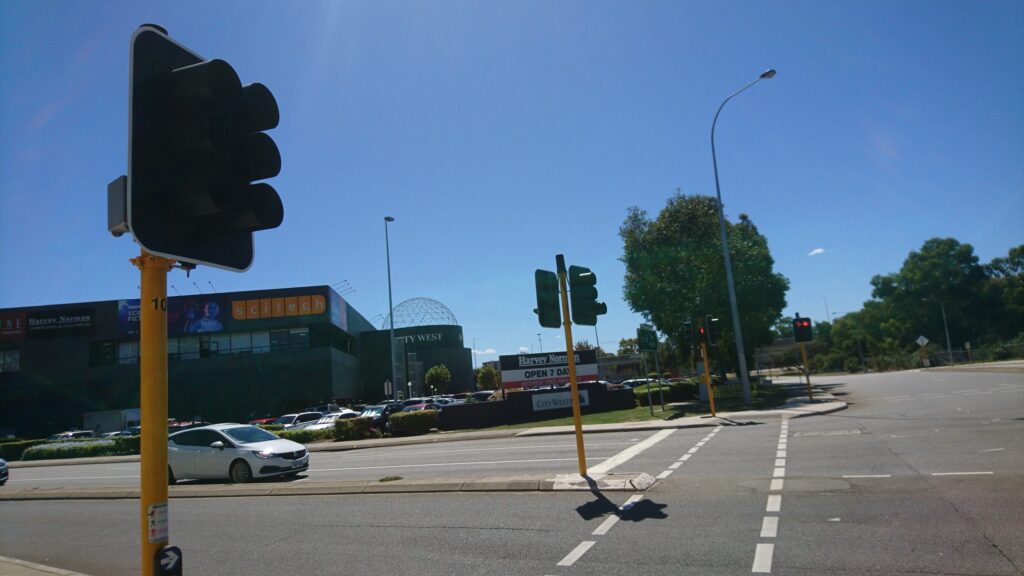We tend to think of traffic the same way we think about weather. It’s something that sort of just … happens. It’s something to shrug your shoulders at. Something that, short of listening to a report on the radio, we can’t do much about.
It turns out that just isn’t true. Prepare to enter a world of mystery, of deep data and invisible influence: the headquarters of Main Roads WA.

Constant vigilance
“For most of our sensors, you wouldn’t know they were there,” says John Venables, Manager of Real Time Traffic Operations at Main Roads.
As you might expect, Main Roads has over 400 cameras, which might have seen you even if you haven’t seen them. In the last few years, they’ve also installed more than 600 Bluetooth sensors. These scan for discoverable devices with a Bluetooth connection and keep an eye on how long it takes them to move down Perth’s highways and freeways.
(It’s not as weird as it sounds. You could do the same thing by opening the Bluetooth settings on your phone and seeing how long it takes “Steve’s iPhone” to do a drive-by. Plus, all the data is anonymised and discarded after 24 hours.)
“Typically, the time it takes for a Bluetooth device to make it from one point to another is within a certain ‘normal’ timeframe,” says John.
“If it takes the device, or a number of devices, longer than the norm, we know that something’s going on, and we can start to investigate whether there’s an incident we need to deal with.”

All of that data streams into a control room that wouldn’t look out of place at NASA, staffed 24 hours a day. So when they spot a problem, what can they do about it?
Chasing cars
“If it’s a breakdown, we deploy a tow truck to move the vehicle out of traffic,” says John.
“We also have incident response vehicles that can shunt vehicles out of the way. You may have seen some of them out there with the big pads on the front that allow us to come up behind the car and just push it out of the way.”
If you’ve ever broken down and had a tow truck just show up, now you know why. Like Batman, they’re always watching.

Seeing the light
Just about the only bit of traffic tech we do regularly see is the humble traffic light, but even those have more going on than meets the eye.
“We’ve got over 1000 traffic signals in WA, and we know the status of each of those from our computers here.” says John.
Not only can they see every traffic light in the state (yes, even outside of Perth), but they can change them too if necessary. That might be keeping them green for longer for emergency vehicles, or setting them to orange flashing for local police to take over.
“We’re probably one of the only states in Australia that does that. Some of the bigger states have more signals than we have, but they don’t all connect into their central system. So we’re quite proud of that.” says John.
Most of the time though, the signals do their thing all on their own with no human intervention required.
“We’ve got sensors under the pavement. Most of them work a bit like a metal detector. So as a piece of metal passes over, typically a car, it notices that change.” says John.
(Pro tip for cyclists: make sure you’re on the dotted line in the middle of the lane, otherwise you might be waiting for a while. Bikes have less metal, so you need to sit over the most sensitive part of the detector.)
So what about pedestrians? Do those delightfully pressable buttons so beloved by Dr Karl and Billie Eilish actually … work?
“If there’s no other traffic around and you’ve got a red light, it will change the signals for you once it’s safe” says John.
But what about pushing it more than once?
“It's a bit like pressing the button for the lift repeatedly.”
“You see it a lot, but it makes no difference at all.”
Heartbreaking.

How to close a highway
If you really want to see it all come together, look no further than Canning Highway on 1 March 2020. A throng of AC/DC fans descended on one of Perth’s busiest roads – and Main Roads was ready.
“We’ve had similar events, but that was probably the most challenging. That 10km of Canning Highway has 110 side streets we had to manage,” says John.
“Closing all of those ... was one of the biggest things we’ve ever done.”

Between helping police, ambulances and at least one fire engine get through, the team noticed something odd. Despite 110 closed side streets, somehow the system still showed traffic moving.
“It was closed to highway traffic and open to pedestrians, but our Bluetooth data doesn’t necessarily know the difference between a car’s Bluetooth and an Apple Watch on a pedestrian,” says John.
“So our data was saying that traffic was moving slowly down the highway. Well, it was moving slowly—at walking speed.”
If that sounds familiar, it’s because a guy with a little red wagon pulled a prank on Google Maps, which uses the location of Android phones to do something similar. It’s a prime example of why putting humans in a situation room is still worth it, even in the age of algorithms.
“The difference is, we knew the reason for it,” says John.
“We have the ability to investigate, whereas Google has to just trust the data and believe that it’s right.”











